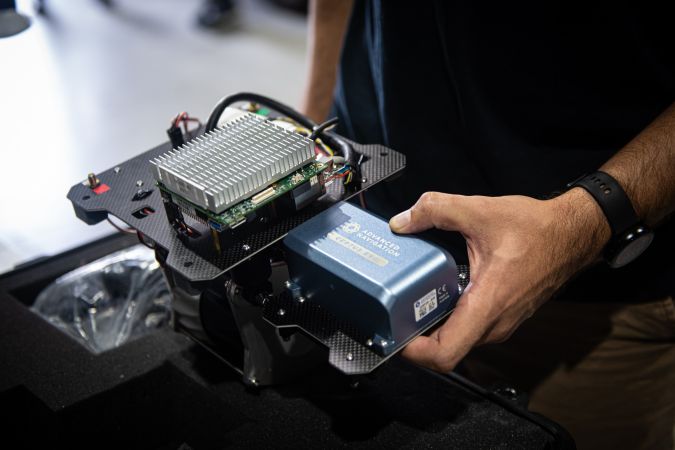LIDAR技术的创新继续改变我们看到世界的方式 - 从字面上看。不可否认的是,激光雷达部门正在以指数级的速度增长。Grand View研究表明到2027年,激光雷达市场的总价值将为37亿美元。
Beyond its applications for autonomous vehicles, Lidar technology is already yielding positive results in the agriculture, archeology and mining sectors. The feeling within the industry is palpable; this is just the beginning. Research institutions and developers around the world continue to engineer the potential of Lidar with exciting progress. One such developer is Nextcore, an Australia-based company who specializes in making Lidar systems mounted on unmanned aerial vehicles (UAVs or ‘drones’). Established in 2012, Nextcore’s solutions have been used in the mining industry by surveyors and environmental specialists all over the world.
NextCore已准备好突破无人机的界限
由创新驱动的一家公司NextCore的团队发现自己问一个简单的问题:我们如何在更高的高度上飞行无人机的LIDAR,同时比以往任何时候都获得更准确的数据?乍一看,这听起来像是一个崇高的野心。毕竟,虽然LiDar的能力比以往任何时候都更有前途,但当UAV安装的LIDAR在地面高度较高(AGL)的较高高度下飞行时,收集的数据质量存在公认的风险。
在过去的60年中,LiDar Technologies迅速扩展,无人用的LIDAR构成了快速增长的市场的很大一部分。从映射更复杂的城市环境,到监视空气质量,再到研究海洋的地下特性,无人机安装的LiDar将为研究人员和企业带来可观的股息。无人机安装的LiDAR可以实现的潜力很大,对于调查特别具有挑战性的环境而言,该技术更安全,更有效,更准确。但是,随着无人机安装的激光雷达的应用程序的范围,该技术的功能需要能够跟上需求。
If there’s one thing that defines the Nextcore team, it’s their passion to continually improve the technology of UAV-mounted Lidar in order to make cost-effective, reliable equipment that is easy to use. This led to the RN80 project, a UAV-mounted Lidar payload that could be flown higher in the air and still deliver a survey-grade dataset.

挑战:无人机安装的激光雷达飞行80米AGL
NextCore的RN50无人机式LIDAR以前只能在50m AGL上飞行,这有与植被相撞的风险。为了避免这种情况,团队设定了将高度提高到地面80m的目标。在此高度上操作不仅降低了与树木碰撞的风险,而且还使测量师能够覆盖更大的区域,从而大大提高了解决方案的效率。但是,这种野心会增加风险。
“The problem with flying a UAV-Lidar payload higher off the ground is that the higher you fly, the more inaccuracies you build into the Lidar dataset,” says Ashley Cox, COO and co-founder of Nextcore. “The challenge was finding hardware we could put into the system that would allow us to achieve a survey-grade outcome even though we were flying our drones higher.” Tom Simmons, technical officer at Nextcore, adds that there is an added benefit of safety that comes with flying UAV-mounted Lidar higher: “We’ve got many clients navigating very mountainous terrain in Japan and Malaysia, and they need the ability to fly higher with their drone,” he says. “You’re really relying on your inertial navigation system (INS) accuracy at that point, and any inaccuracy that you’ve got in will be reflected in your Lidar,” he continues. “So any inaccuracies from the INS will be accentuated by flying higher, leading to a decrease in accuracy in your point cloud generation and it won’t be usable data for surveying metrics.” Keeping this in mind, Nextcore needed a top-class GNSS/INS solution that performed reliably in any conditions whilst remaining accurate to the centimetre.

The solution:证明EVOMEMS GNSS/INS
After reviewing the different inertial navigation systems available on the market, the Nextcore team selectedAdvanced Navigation’s证明EVO出于以下原因,要在RN80有效载荷中使用:
- It was a highly accurate MEMS GNSS/INS, reducing any angular errors from flying higher
- 很容易整合到NextCore的现有系统中
- 这是具有成本效益的,允许NextCore将储蓄传递给其客户。
证明EVOprovides accurate position, velocity, acceleration and orientation under the most demanding conditions. It combines ultra-high-accuracy temperature-calibrated MEMS accelerometers, gyroscopes, magnetometers and a pressure sensor with a dual-antenna RTK GNSS receiver. These are coupled withAdvanced Navigation’s复杂的融合算法,以提供准确的导航和方向。
The Nextcore team had usedAdvanced Navigation’sSpatial Dual previously for their RN50 project, so they were naturally intrigued by the potential of the证明EVO当它被释放时。汤姆反映了证明EVO’sspecifications made it able to meet their ambitious 80m AGL flight height. “After doing some test flights, it met all of our requirements for the RN80 project,” he says. “This allowed us to leverage off the Spatial Dual integration and apply the证明EVO作为该系统的倒入替换。它确实减少了那里的发展时间。它也是一个非常具有成本效益的传感器,并且在市场上的价格非常有竞争力,尤其是对于澳大利亚制造的产品。”

The outcome: soaring above expectations
Upon completing the project, the Nextcore team were pleasantly surprised to find that the RN80 surpassed their expectations. “Based on our calculations, we expected we’d be able to fly 80 metres above ground level,” says Ashley. But in fact, the证明EVOperformed so well it enabled Nexctore to produce a UAV-mounted Lidar that operates at 100 metres above the ground, exceeding their initial goal. This became the RN100 UAV-Lidar, which allows Nextcore’s customers to fly more safely, cover a larger area and still achieve a survey-grade outcome.
As the potential for Lidar continues to develop, the outcome of the RN100 is now well suited to meet the demands of the growing market with a high-performance, accurate system. For Nextcore, this development has opened up an exciting window of opportunity. Ruminating on the RN100’s development, Tom attributes the project’s success not only to the highly accurate证明EVO,但也易于集成到他们的r system. “Moving fromAdvanced Navigation’s空间偶到证明EVO对我们来说是一个非常简单的集成项目。”他说。正如许多制造商所知道的那样,使用共享界面可以使开发团队快速整合系统。“我们能够利用我们所有现有的开发工作,并将其快速,可靠地整合到我们的下一个完整单元中,以便快速发布该产品,”汤姆说。“因此整合证明EVOfromAdvanced Navigationallowed us to offer a higher-end product to our clients at an affordable price tag. And this has really opened up new markets for us, internationally and domestically.”
The future of UAV-Lidar
飞行无人机的激光雷达的潜力令人兴奋。使用证明EVO,NextCore已表明可以在100m AGL飞行,并且仍然提供最高的调查数据。了解更多有关证明EVO, visitAdvanced Navigation’swebsite and get in touch with the company’s expert team.

